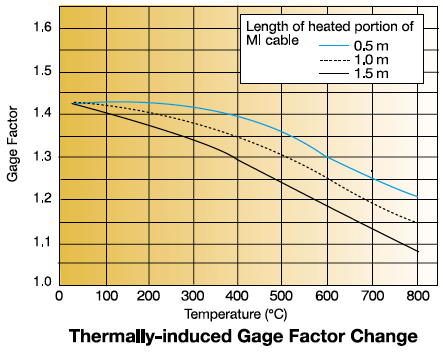This is just example of the Weldable Strain Gauges available at Sensors UK. You can view the whole range on our Weldable Strain Gauges pages.
KHC - Static/Dynamic Strain Measurement High-Temperature Encapsulated Weldable Strain Gauges



Precautions
• In the case of models with the bridge adapter pre-attached, leadwires of the bridge adapter can be connected directly to a static strain measuring instrument such as UCAM-6OB, but the leadwires should be connected to a dynamic strain measuring instrument such as EDX-1 OOA via an optional input cable.
• Models with no bridge adapter pre-attached require an optional dedicated adapter.
• Study the features of high-temperature encapsulated weldable strain gages and follow the instructions as described in "To Ensure Safe Usage of Encapsulated Weldable Strain Gages".
• Mount the sensing part carefully so that the part may not receive any unreasonable force or may not be bent locally.
• It is recommended to use a measuring instrument of constant DC voltage application type such as UCAM-5OOB, CDV, etc.
Download the Encapsulated Weldable Strain Gauges PDF.
KYOWA encapsulated weldable strain gages are hermetically sealed. They consist of a sensing part and a cable to transmit output signals from the sensing part. The sensing part is composed of a metal tube and a flange. The highly heat resistant metal tube has strain-gage element(s) and insulation material sealed in. The flange is spot-welded to the measuring point. The cable is a mineral-insulated metal sheathed cable (Ml cable) filled with heat-resistant insulating powder in which the leadwires are embedded.
This structure enables these strain gages to measure strain under harsh environments affected by high temperature, high pressure or high humidity. High-temperature models can be applied to strain measurement in fields including nuclear/thermal power generation, automobiles and aircraft. The normal-temperature model features waterproof construction and long-term stability, and thus is suitable for outdoor strain measurement in the automobile, civil engineering, architectural and many other fields.

Hermetically sealed structure provides excellent environmental capability. The gauge element and leadwire cable (Ml cable) are
covered with heat and corrosion resistant metal (lnconel 600, etc.) and integrated, enabling strain measurement at high temperatures or under high pressure, seawater or pure water.
Strain-gauge element is made of heatresistant special alloy.
Minimal thermally-induced apparent strain ensures highly accurate measurement
(KHCX, KHCR, KHCS, KHCM, KHC).
The half-bridge structure has a dummy gauge for temperature compensation, and the applicable linear expansion coefficient can be selected according to the measuring object. Furthermore, the temperature compensation resistor compensates apparent strain
initiated by the linear expansion coefficient of the leadwire cable. Together these features minimize thermally-induced apparent strain, enabling highly accurate strain measurement.

Substantial Test Data Sheet enables highly accurate strain measurement.
The Test Data Sheet accompanying each product describes temperature and zero (bridge balance) compensation resistance values. If the operating temperature range or the length of the heated portion of the Ml cables are different from the ones shown in the graph below, contact us about the details. The estimated thermally-induced apparent strain and the gauge factor change will be provided together with the graph. (Gauge factor change is only for the KHCV.)

With the KHCV, gauge factor is improved by approximately 50% over our forerunner previous model.
This is realized through improvement of the spot-welding method and adoption of a low-resistance Ml cable. Also realized is the 120 Q gage resistance in 5 mm gauge length.
Applicable linear expansion coefficients of 11, 13 and 16 x1o-6/ C are available standard. (11 and 13 x1o-6/ C only for
KHCX)
Models with other applicable linear expansion coefficients can be manufactured as desired by users. (Since the KHCV is designed for dynamic strain measurement only, it does not provide any temperature compensation.)

Models with bridge adapter option cut down on labor time and increase reliability.
The bridge adapter has the temperature compensation resistor wired (KHCX, KHCR, KHCS, KHCM, KHC). This not only eliminates the need for wiring the resistor to the bridge adapter but also facilitates connection to the measuring instrument.
Temperature Compensation Method and Bridge Circuit (KHCX, KHCR, KHCS, KHCM, KHC)
With foil strain gauges, a half bridge configuration using active and dummy gauge elements enables compensation of the output initiated by the temperature coefficient of the resistive material of the gauge elements and the output initiated by the difference between the linear expansion coefficient of the gage elements and that of the measuring object.

In the case of encapsulated weldable strain gauges, the dummy gauge element has no sensitivity, disabling compensation of the output initiated by the difference between the linear expansion coefficient of the gauge and that of the measuring object. This results in apparent strain-output corresponding to the difference between the linear expansion coefficient of the active gauge element and that of the measuring object. To compensate the apparent strain, external temperature compensation resistors (RTc) are inserted to the bridge circuit. Furthermore, external temperature compensation resistors (RLc) are inserted to the bridge circuit to reduce the apparent strain initiated by the heated Ml cable. The bridge balance broken by these resistors is corrected by
balance adjustment resistors (RBAL). Each product is delivered with all of these resistors featuring the optimum values for the user's operating temperature range.

To facilitate configuration of the bridge circuit including these resistors, a bridge adapter is provided which will be pre-attached to the soft cable when delivered.
Weldable type ensures easy installation in the field
The spot-welding method facilitates installation of gages to the measuring point. The sensing part is
covered with stainless steel and requires no additional installation work such as coating. The cable integrated
structure also ensures easy handling.
Outstanding waterproof construction and long-term stability
The normal-temperature model can endure water pressure of approximately 10 MPa for 24 hours. Thus, it can safely be used outdoors, underwater or in highly humid environments.
Affordable
When compared with high-temperature models, the normal-temperature model is economically priced.



